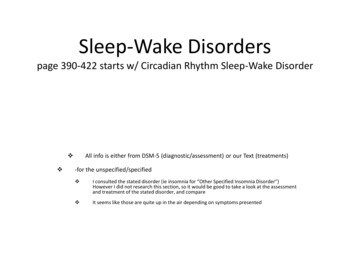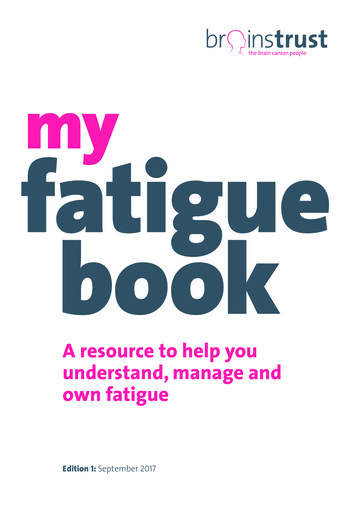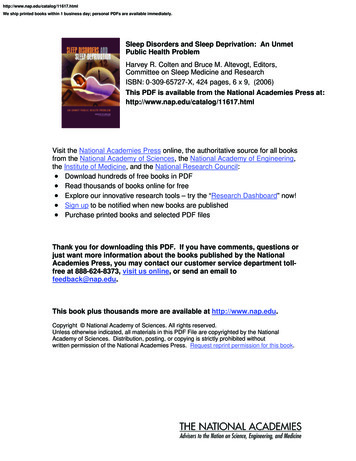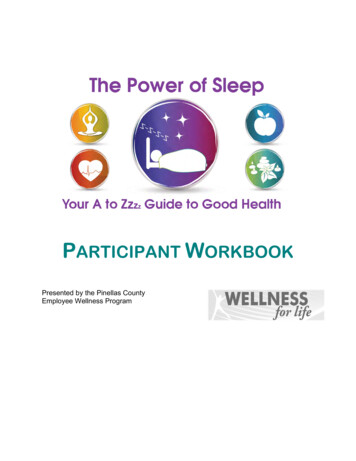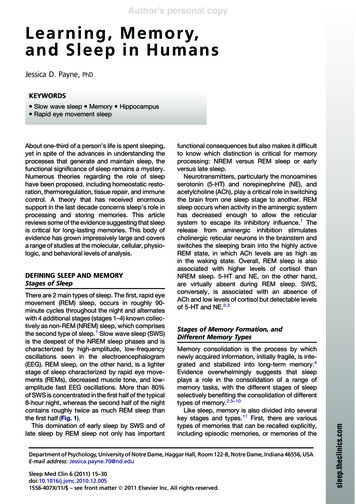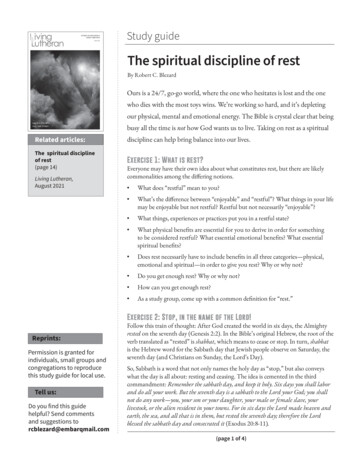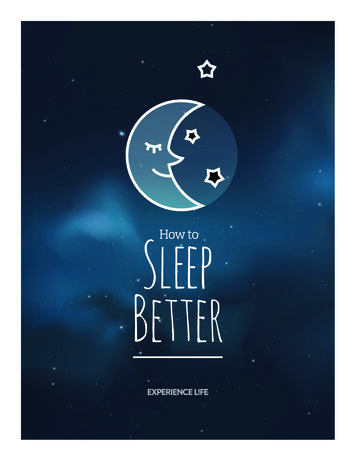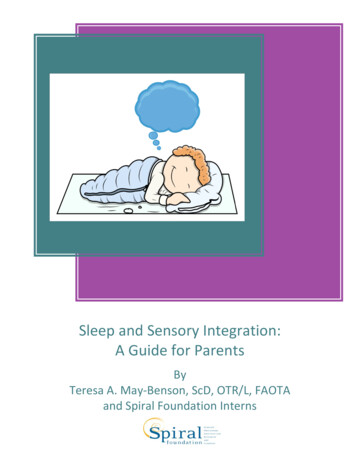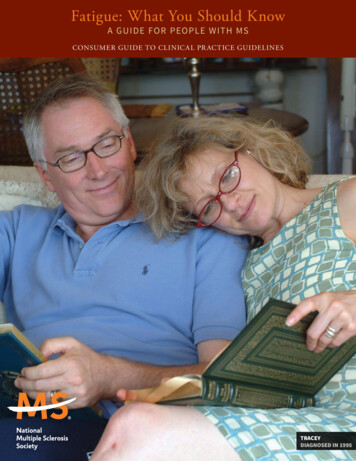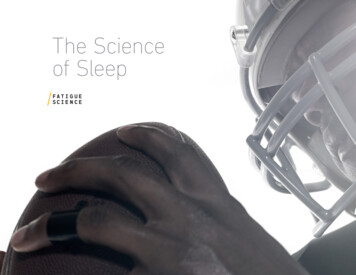
Transcription
The Scienceof Sleep
HUMAN PERFORMANCE MODELInfluencers of wins and lossesSleepHydrationNutritionGETTINGTHE quipmentGAMETIMELuckSleep plays a key role getting athletes ready to compete and has a direct,measurable and highly predictable effect on player performance. With a basicunderstanding of sleep science and the right tools, sleep can be managedthe way other building blocks of human performance like conditioning andnutrition are.On game day, winning or losing may come down to a ref’s call or just plain luck,but athletes need to be ready to face those influencers in top form. Achievingtheir physical best involves constant management of a host of readiness factors.Sleep is too important to be left off that list.CoachingOfficiatingUnderstanding the mostuntapped contributor tobetter team performanceTalentSkill/2
Mental and physical fatiguearen’t the same thingAt Fatigue Science, when we talk about fatigue, we’re talking about reducedalertness, reaction time, and effectiveness—all of which manifest in the form ofsub-optimal athletic performance. This mental fatigue happens when sleep andactivities fall outside of our very specific biological needs to consistently sleep atnight and be active in the day—it’s not the same as fatigue resulting from physical exertion.Those who routinely obtain less than 7-9 hours of interrupted sleep per 24-hourperiod will have a high homeostatic drive for sleep as the body struggles torestore balance. In addition, scheduling inconsistencies often lead to a highcircadian drive for sleep at exactly the wrong times of day as well as tosleep-initiation problems at night. So, when athletes lose sleep due to anynumber of factors, when they’re unable to stick to a consistent bedtime dueto travel or social engagements, and when they have to train or play at the“wrong” times in a new time zone, they’ll be faced with both a high homeostaticand a high circadian drive for sleep. The result will be impaired judgment, reaction time, and situational awareness—the hallmarks of poor mental effectiveness./3
Unfortunately, we can’t train our homeostatic and circadian requirements totolerate stress like we can train our cardiovascular organs, respiratory system,and muscles. Sleep deprivation or circadian desynchronization will cut into thecognition and effectiveness of every human being, whether they’re physicallyfit or not, without discrimination—and when we’re deprived of sleep, ourperformance suffers.Cognitive fatigue and physical fatigue are very different from one another,though the two can co-exist. While there’s very little evidence that bursts ofphysical exertion impact judgment or reaction time, there’s plenty of researchto support the influence on the psychological over the physical. We’ll explainthis further when we examine factors of performance impacted by sleep inmore detail./4
“ With sleep, we reset our memory,reduce metabolic demand on thebrain, and stay alert. Nothing ismore fundamental than that.”— Dr. David Dinges, sleep researcher and Professorat the University of Pennsylvania School of Medicine/5
SLEEPDEBTAt any given time, one’salertness is influencedby three thingsSleep debt (quantity of sleep)SLEEP/WA KETIMINGTo function in top form, athletes must clock 8-9 hours of sleep every 24 hours.Consistently coming up short (an hour here, and an hour there), creates sleepdebt, and the more of a deficit we carry the harder it is to recover an evenbalance.In elite team environments, creating adequate opportunity for players to getoptimal sleep is difficult due to compressed travel, training and game schedules,as well as media and promotional activities. The science is clear though—theless sleep we get, the less alert we’ll be.TIME OFDAYSleep/Wake timing (consistency of sleepingand waking relative to diurnal pressures)It’s not just how much sleep we get, but the consistency of when it’s obtained.When we cooperate with our diurnal nature to sleep at night and be active duringthe day, the restorative value of sleep is maximized, and the quality of wakingperformance is optimized./6
From a homeostatic standpoint, the longer someone is awake, the greater thepressure to sleep. But when an athlete’s opportunity to stick to a sleep/wakeroutine is disrupted by travel, late games or other commitments, it’s not onlywaking performance that will be affected—nighttime sleep will be impactedas well.Time of day (the influence of our circadian rhythm)Let’s assume an athlete sleeps well for eight hours from 11pm to 7am.Throughout the coming day, his reaction time will vary up to 10% as his bodyexperiences troughs and peaks in alertness. These natural troughs andpeaks are our well-rested daytime baseline—an ebb and flow of cognitiveeffectiveness based mostly on circadian factors.Circadian factors influence athletic performance to such a degree that, basedon 40 years of win-loss data, west coast NFL teams have proven dominantwhen playing evening games on the east coast. Imagine harnessing thisknowledge for your team: you can’t change game times, but to some degree,can influence the timing of these daily circadian 018:0019:0020:0021:008022:0023:0000:00/7
When viewed as an ecosystemof either preparedness orunpreparedness, it becomesclear that sleep loss andcircadian disruptions impactcompetitive edge./8
A tale of two sleepers: the shots-on-goal comparisonPlayer 016:0017:0018:0019:0020:0021:0022:0023:0000:0098 Game TimeEffectiveness9 hours of sleep with few interruptionsPlayer :0010:0011:0012:00Less than 6 hours of sleep with multiple interruptionsPlayer A, a pro soccer goalkeeper, averages closeto nine hours of quality sleep each night, withgood consistency and quality. At the start of anevening game, his effectiveness score is 98.His decision-making, in-play responsiveness,strength and speed, and physiological sharpnessare at their 22:0023:0000:0087 Game TimeEffectivenessPlayer B, also a keeper, averages seven hoursof sleep at best with commonly disrupted orinterrupted periods. The night before the game,he slept for less than six hours. His pattern ofinadequate and low-quality rest—and thecognitive fatigue that results—slows his reactiontime at game time by 20%.Who would you put in the net?
What else is sleepinfluencing in your athletes?Sleep deprivation not only reduces reaction time and decision-making ability.It impairs immune functions, physical and psychological performance,motivation, memory consolidation, and increases risk of injury, anxiety, stress,and inflammatory markers. Finally, since sleep loss affects motivation andappetite regulation, it predisposes people to weight gain and increased bodyfat percentage. Even though physical fatigue has little to no impact on mentalalertness, the reverse is true—mental fatigue has a great dealof impact on physical performance. This is how a competitivedecline takes root under conditions of sleep loss.An athlete who sleeps consistently well will demonstrate high effectivenesseven when physical energy has been temporarily depleted. Athletes withinsufficient sleep will still be able to run, lift weights, and perform with basiccapacity and resilience. But their time to physical exhaustion will be shorter,their perception of exertion and endurance distorted, and their motivation,judgement, alertness, decision-making, and situational awareness impaired.This is what more than 25 years of military research tells us: although mentaland physical fatigue are not directly linked in a mechanical or biological way,the two are inextricably intertwined./ 10
To begin to understandsleep’s influence on teamperformance, it needs tobe measuredIn sleep and fatigue research, there are three common ways to measure sleep.PSG (polysomnography)ActigraphySelf-ReportingThe gold standard, PSG isthe most comprehensive,most reliable form of sleepmeasurement. It involvessubjects sleeping in a labwhere various physiologicalfunctions are monitored.By capturing body movement via a wrist-worndevice, actigraphy is anon-invasive method ofmeasuring sleep/wakepatterns.A low-tech substitute isdiary-keeping. This strategyrelies on an individual’sability to estimate or recallhis own sleep pattern.100% accurate93% accurate when using thescientifically validated FatigueScience Readiband50-60% accurate—mostrespondents overestimatetheir sleep by as much as70 minutes/night/ 11
While Polysomnography is the most accurate way to measure actual sleepobtained, it’s not practical in an elite team environment. Actigraphy, on the otherhand, is simple, cost-effective, and practical. And while there are many actigraphy devices available, the Fatigue Science Readiband is both scientificallyvalidated and trusted by researchers with the US Army, US Special OperationsCommand, and Harvard University./ 12
6 hours sleep4 hours sleepPeople aren’t great atestimating how much sleepthey get and its impact ontheir performance8 hours sleep20Vigilance Lapses151050-5BL2468101214101214Days of sleep restrictionStanford Sleepiness Scale3.02.01.00Conducted by the University of Pennsylvania School of Medicine, a sleep restriction study that put subjects through fourteen days of restricted sleep showeda predictable and sharp increase in the number of vigilance lapses or mentalerrors (top left). Then, those same subjects were asked to self-report their fatigue using a standardized subjective measure: the Stanford Sleepiness Scale.During the first few days of sleep restriction, subjects were fairly accurate atself-reporting their level of fatigue (how tired they felt), but as the study (andtheir sleep deprivation) intensified, they failed to recognize their significantlyincreasing levels of tiredness (bottom left).-1.0BL2468Days of sleep restrictionVan Dongen, Maislin, Mullington Dinges, 2003/ 13
Researchers call it ‘renorming’—when we assess our physicaland mental state, we can’t helpbut compare how we feel todayto how we felt yesterday or theday before. We quickly forgethow we felt even three days ago./ 14
From a research settingto the real world, a meansof predicting fatigueTo better understand fatigue in the realm of elite sports, what’s needed is a toolthat can predict change in mental effectiveness based on actual sleep obtainedand the timing of that sleep in relation to the body’s internal clock. And it mustbe both convenient and accurate.Tasked with understanding the effect of disrupted sleep on critical operations,the US military’s brightest minds devised a biomathematical model that simulates the effects of sleep loss on mental effectiveness. This model, called SAFTE(Sleep, Activity, Fatigue, Task, Effectiveness), is the result of more than 20Mdollars investment and 25 years of applied research. Today, it’s used to mitigatefatigue onboard Air Force One and remains the working fatigue model of the USDepartment of Defence.SAFTE’s accurate prediction of the effects of fatigue on reaction time and otheraspects of mental effectiveness is proven through a number of studies, includingthose conducted by Universities, the US military, the US Department of Transportation and the Federal Aviation Administration./ 15
9 hours sleep7 hours sleep5 hours sleep3 hours9 sleephours sleep7 hours sleepRestrictionRecovery110Mean Speed (as a % of baseline)SAFTE fatiguemodel: somevalidation studiesBaseline9580SAFTE Prediction655 hours sleep3 hours sleep50Day 0T1T2BE1E2E3E4E5E6E7R1R2R3Hursh, Redmond, Johnson et al, 2004To validate the SAFTE model, the Walter ReedArmy Research Institute restricted participants’sleep for seven consecutive nights, and had themdo reaction-time and other tests at regular intervals throughout the day to determine the effectsof sleep loss on performance. At the end of theweek, subjects were given the chance to sleep fora solid eight hours per night—with the intention ofallowing researchers to assess the speed at whichsubjects could recover from the imposed sleeprestriction. The laboratory setting ensured thecapture of excellent sleep data, which was thenfed into the SAFTE model to assess the latter’sfatigue prediction accuracy. Researchers foundthat SAFTE was 94% accurate in predicting notonly performance declines, but also the patternof performance recovery.More recently, the FAA conducted another studyused Fatigue Science Readibands to measureactual sleep obtained in an operational context.After collecting and analyzing more than 10,000sets of performance data from 200 on-duty flightattendants, it too demonstrated SAFTE’s predictive accuracy. And in this case, given the broadspectrum of participants, affirmed that fatigueas a result of sleep loss and schedule disruptions,is highly predictable across the adult population.
Because sleep can bemeasured, it can be managedin a team environmentYou know sleep is a crucial component to your high performance managementprogram. You also know it’s challenging to address without the tools or know how.As with any program aimed at gaining a competitive advantage, the solutionsstart with an objective look at where the opportunity for improvement lies.Measuring sleep is a first step in better understanding your athletes—how theymanage their sleep, how their sleep is affected by late games, early practices,rigorous travel, post-season stress, their state of health and other factors.By understanding how sleep influences your athlete’s daily alertness and abilityto perform effectively, you’ll have a host of inputs to put them on higher ground.For example: make decisions to better limit the overall impact of sleepand circadian disruptions on team performance, and; justify sleep and proper sleep management to individualsas part of a key training responsibility/ 17
To learn about Fatigue Science’s Team Platform,designed specifically for sports teams, get intouch with us.jacob.fiedler@fatiguescience.com1 (604) 408-0085About Fatigue ScienceFounded in 2006 and based in Vancouver BC, Fatigue Science is atrusted pioneer in sleep and its relationship to human performance.We work with pro sports teams like the Seattle Seahawks, DallasMavericks and the Vancouver Canucks to provide technology-enabled,data-driven insights that help them perform better at game time.We’ve developed the Fatigue Science Readiband, a scientificallyvalidated actigraph device, and hold exclusive commercial rightsto the SAFTE fatigue model./ 18
References and recommended readingsÅkerstedt T., Wright Jr.K.P. (2009). Sleep Loss and Fatigue in Shift Workand Shift Work DisorderBanks S, Van Dongen H.P.A., Maislin G., Dinges D.F. (2010). Neurobehavioral DynamicsFollowing Chronic Sleep Restriction: Dose-Response Effects of One Night for RecoveryBogdanis G.C. (2012). Effects of physical activity and inactivity on muscle fatigueCajochen C, Khalsa S.B., Wyatt J.K., Czeisler C.A., Dijk D.J. (1999). EEG and ocularcorrelates of circadian melatonin phase and human performance decrements during sleep lossCajochen C., Krauchi K., Wirz-Justice A. (2003). Role of Melatonin in the Regulationof Human Circadian Rhythms and SleepCzeisler C.A., Gooley J.J. (2007). Sleep and Circadian Rhythms in HumansDijk D.J., Lockley S.W. (2002). Functional Genomics of Sleep and Circadian Rhythm.Invited Review: Integration of human sleep-wake regulation and circadian rhythmicityDurmer J.S., Dinges D.F. (2005). Neurocognitive Consequences of Sleep DeprivationHursh S.R., Redmond D.P., Johnson M.L., Thorne D.R., Belenky G., Balkin T.J., Storm W.F.,Miller J.C., Eddy D.R. (2004). Fatigue Models for Applied Research in WarfightingHursh S.R., Raslear T.G., Kaye A.S., Fanzone Jr. J.F. (2006). Validation and Calibrationof a Fatigue Assessment Tool for Railroad Work Schedules, Summary ReportKrausman A.S., Crowell III H.P., Wilson R.M. (2002). The Effects of Physical Exertionon Cognitive PerformanceLieberman H.R. (2007). Cognitive methods for assessing mental energyLeproult R., Van Cauter E. (2011). Effect of 1 Week of Sleep Restriction on TestosteroneLevels in Young Healthy Men/ 19
Mah C.D., Mah K.E., Kezririan E.J., Dement W.C. (2010). The Effects of Sleep Extensionon the Athletic Performance of Collegiate Basketball Players. Table 2, p946Plyley M.J., Shephard R.J., Davis G.M., Goode R.C. (1987). Sleep deprivationand cardiorespiratory function. Influence of intermittent submaximal exerciseReilly T, Piercy M. (1994). The effect of partial sleep deprivation on weightlifting performanceRoma P.G. Hursh S.R., Mead A.M., Nesthus T.E. (2012). Flight Attendant Work/RestPatterns, Alertness, and Performance Assessment: Field Validation of BiomathematicalFatigue ModelingRussell, C.A., Caldwell, J.A., Arand, D., Myers, L.J., Wubbels, P., Downs, H.Validation of the Fatigue Science Readiband Actigraph and Associated Sleep/WakeClassification AlgorithmsSedgwick P.M. (1997). Disorders of the sleep-wake cycle in adultsSilver R, LeSauter J. (2008). Circadian and Homeostatic Factors in ArousalSmith R.S., Efron B, Mah C.D., Malhotra A (2013). The Impact of Circadian Misalignmenton Athletic Performance in Professional Football PlayersStrogatz S.H., Kronauer R.E., Czeisler C.A. (1987). Circadian pacemaker interfereswith sleep onset at specific times each day: role in insomniaVan Dongen H.P.A., Dinges D.F. (2002). Investigating the interaction between thehomeostatic and circadian processes of sleep–wake regulation for the prediction ofwaking neurobehavioural performanceVan Dongen H.P.A, Maislin G, Mullington J.M., & Dinges D.F. (2003). The cumulative costof additional wakefulness: dose-response effects on neurobehavioral functionsand sleep physiology from chronic sleep restriction and total sleep deprivation.Sleep, 26, 117-126.VanHelder T., Radomski M.W. (1989). Sleep deprivation and the effect on exercise performanceWinter W.C. & Kutscher, S (2013). Fatigue and sleep linked to Major League Baseballperformance and career longevity. Retrieved from www.aasmnet.org/articles.aspx?id 3941/ 20
Sleep plays a key role getting athletes ready to compete and has a direct, measurable and highly predictable effect on player performance. With a basic understanding of sleep science and the right tools, sleep can be managed the way other building blocks
